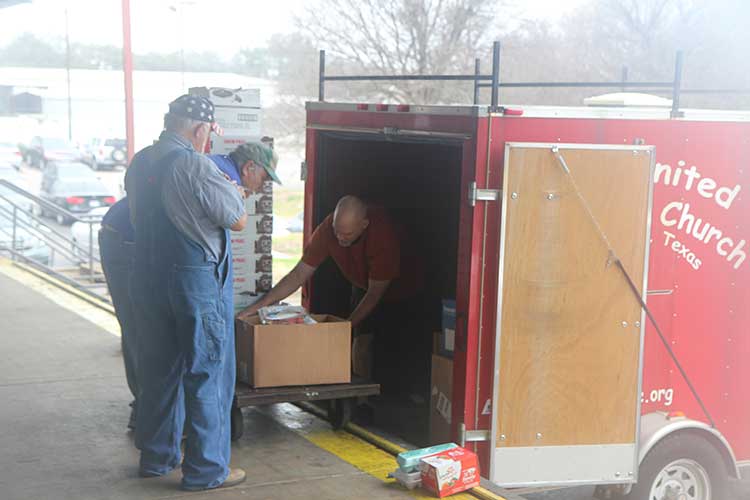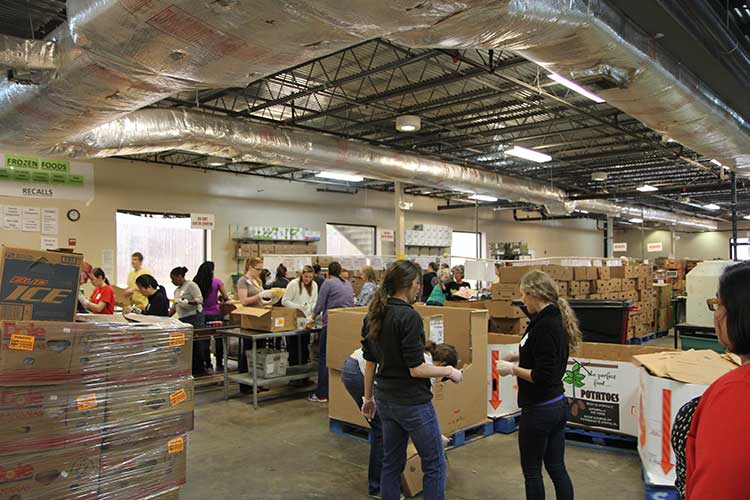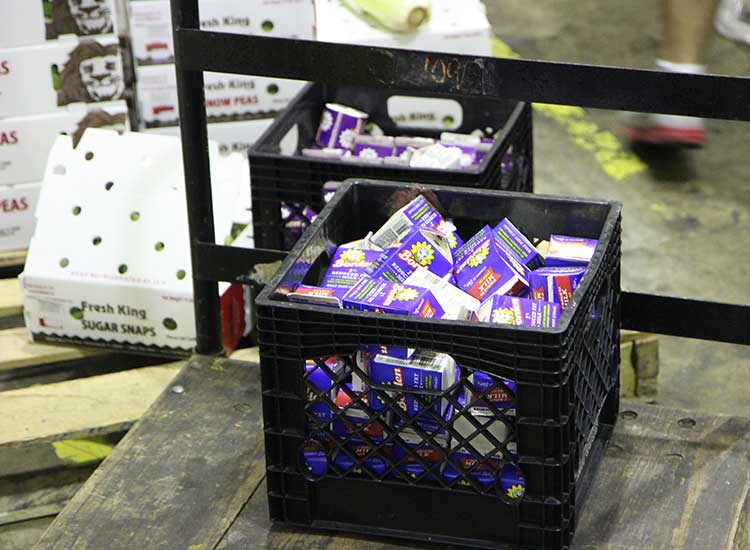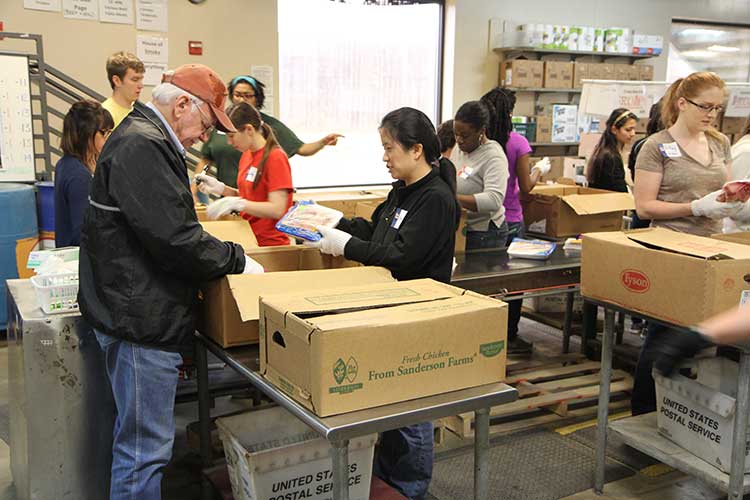Capital Area Food Bank – Feeding the Needy in Austin, Texas
As a child of the working poor, my mom fed us from the food bank, food stamps, and the day-old bread store for several years when I was young. I learned to spot WIC-approved items in the grocery store and how to choose the bread that wasn’t too stale.
My brother and I were also on the government-assisted school lunch program. I still remember how mortified I was when one day the lunch lady announced to the whole cafeteria line that my reduced-cost lunch card had run out and I owed her 25 cents. I didn’t have 25 cents. She let me have my lunch, but with an admonition to bring a check from my mom the next day. Food security is a subject dear to my heart, especially the security of children. When I had the opportunity to interview a rep from the Capital Area Food Bank, I took it. I wanted to see how the food bank system has changed over the years.
Mornings are bustling at the Capital Area Food Bank. Volunteers and staff work efficiently to inspect and sort thousands of pounds of food donations every day, checking for elapsed expiration dates, intact packaging, and blacking out the bar codes before organizing by type into plastic bins and empty banana boxes. Bins and boxes are then fork-lifted into their proper storage areas: dry shelving, freezer or refrigerator until they are picked up by other volunteers from any one of the over-300 Partnership Agencies that work with CAFB to distribute food to those in need. As the largest hunger relief organization in Central Texas, CAFB serves 21 counties and 300,000 clients a year. The entire warehouse of inventory (over 100,000 square feet total) turns over every 20 days.
Food is donated by several local retailers (HEB is the largest donor) and organizations or collected from fundraisers. Cash donations are especially helpful as they allow CAFB to fill out the pantry with more fresh produce and the most heavily-requested items. Every dollar donated to CAFB turns into $5 worth of food, thanks to wholesale pricing gained through grocery store partnerships and local farms like Johnson’s Backyard Garden. Fresh produce is the largest growing product area and partner agencies are allowed to take as much of it as they need from the coolers. Canned meats (tuna, stew, chili), canned vegetables, healthy cereals, dry pasta and sauce, beans and peanut butter are the most requested items. Pop-tops on cans are preferred as not every client has a kitchen, or even a home. For their disaster-relief efforts such as after the West fertilizer plant explosion and the Bastrop fires, pop-top cans are best for people who’ve been temporarily displaced into shelters or hotels. In addition, CAFB accepts and distributes donations of non-food items like disposable diapers, bottled water, and personal hygiene products.
“According to the most recent census data, more than one in five Texans is food insecure and have difficulty meeting basic nutritional needs; nearly 1 in 4 children in our area is at risk of hunger.”
I met with Sara Peralta, Communications Manager, to get a tour of the warehouse and learn more about the work done by the Capital Area Food Bank. One of the most refreshing aspects I saw in Sara and the volunteers is their commitment to the people they serve. In the wake of the SNAP (Supplemental Nutrition Assistance Program) benefits cut, it’s comforting to know that there are people working diligently on one of the purest missions in life: feeding hungry people.
Who uses your services?
48,000 Central Texans rely on our services each week – 20,000 (41%) of whom are children. The face of hunger today include children, seniors, anyone living on a fixed income, the unemployed and working families struggling to make ends meet.
Where do you get funding and donations?
CAFB is a non-profit organization that relies on contributions to pay most operating expenses. Individuals, corporations and foundations all contribute to CAFB, which is one of the best financial investments in the community. Nearly 96 percent of all resources received by CAFB are returned to the community in programs and services. And with every $1 donated, CAFB provides 2.5 meals. CAFB distributes more than 29 million pounds food and grocery products each year. Although the agencies pay a small handling fee [12 cents per pound of dry goods; all other items are free] for the food they receive, the total of those fees is less than $800,000 per year for more than 300 agencies. This means that millions of dollars are saved by CAFB Partner Agencies — money that can be used for programs and other needs.
What changes have you seen at CAFB since SNAP benefits were cut?
For our clients receiving food stamps, they saw their benefits reduced an average of $36 a month for a family of 4 in November. The sequester cuts in 2013 deprived Central Texans from access to unemployment assistance, housing assistance and other services that keep people out of poverty. Now they are entering the hunger lines, sometimes earlier in the month and others for the first time. We make it possible for children to perform well in school, families to afford to put gas in their car so they can go to work, and for seniors to afford their medicine by taking away the stress of not having enough food each day.
Capital Area Food Bank also organizes cooking and nutrition classes in the 21 counties it serves. “Anywhere they’ll have us,” laughs Sara, including schools, senior centers and churches. Volunteers and staff work to create healthy meal plans that can be made from pantry staples, then share the recipes, safety tips and ideas with students of all ages. Nutritionists teach kids and adults how food affects health and about the importance of exercise and activity. Hands-on cooking lessons geared towards children teach important life skills. All the classes are free to anyone who qualifies.
Seventy five employees and 19,000 volunteers work to keep CAFB running smoothly. During the Thanksgiving and Holiday seasons, when giving is on everyone’s mind, the extra volunteers are a great help to sort the higher influx of donations. But it’s important to keep in mind that volunteers are needed year-round. “Someone who was hungry at Christmas is still hungry [in February].”

Rain or shine, volunteers from First United Methodist pick up donations weekly to distribute in Pflugerville
What volunteer positions do you need the most help with?
Volunteers are essential to the Food Bank. Each month, volunteers contribute more than 7,000 hours to support the Food Bank’s mission by sorting donations, serving clients, teaching classes, assisting at special events, serving as ambassadors and participating in a variety of other opportunities. We are always looking for help sorting donations and making sure they safe to give to our clients.
Any other ways people can help?
Donations and volunteers make it possible for us to connect more people to healthy food and reduce the health risks associated with an insufficient (or poor) diet.
• Every $1 donated provides $5 worth of food or about two and a half meals.
• Healthy non-perishable food donations like canned meats, low sodium soups, peanut butter and whole grain cereal are most needed and requested by our clients. Pop-top canned goods are especially effective.
• Volunteers are critical to ensure all donated food is safe for distribution and meets our quality standards. Kids as young as 8 can volunteer and it’s perfect for large groups.
• Help us inform elected officials and your neighbors about this growing public health crisis. We have lots of great information on our blog and website to help you share our message and get involved.
Resources:
A full list of CAFB partner agencies by county is located here.
A list of CAFB nutrition and cooking classes is here.
Learn about the summer food program for kids at CAFB here.
2 Comments
Leave a Comment













Thanks for sharing this story.
Thanks for reading it! 🙂